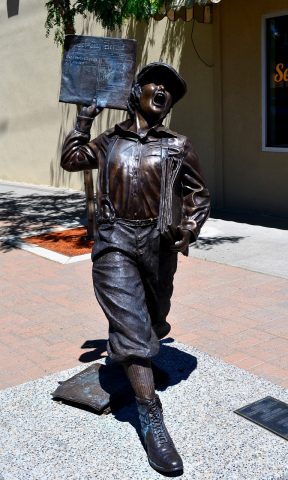As well as Labor Day, the month of September boasts many other “national” days, including National Newspaper Carrier Day. It’s a day that celebrates an American worker with a pivotal role in the nation’s history.
National Newspaper Carrier Day is celebrated on September 4. It honors the humble paperboys and girls who deliver your daily newspaper.
Hawking pamphlets and other wares in the street is not a recent phenomenon; it has a long history dating back over thousands of years. But, when it comes to hawking newspapers in the street, in the USA the practice is usually traced back to an 1833 advert in the New York paper, The Sun.
Printer Day
The paper’s then publisher, Benjamin Day, placed an advertisement which read: “A number of steady men can find employment by vending this paper. A liberal discount is allowed for those who buy to sell again.”
Day had been a printer in New England who founded The Sun in 1833 with a unique selling point – it sold for a penny. His “penny press” targeted a new, growing working-class audience with an affordable newspaper and represented a genuine milestone in American journalistic history.
A ten-year-old boy, Blarney Flaherty, answered Day’s ad and, on September 4, 1833, Benjamin Day hired Blarney as the first paperboy in the USA.
We know this because, in September 2012, The Museum of the City of New York released a photo of the boy from their extensive archives. The photo had been taken by Jacob August Riis, a Danish-American social reformer, “muckraking” journalist and social documentary photographer who immmigrated to New York in the 1870s.
Newsboys in the city
Following Day’s hiring of Flaherty, newsboys became a prominent fixture in New York City – and the trade turned out to be a means of support for many thousands of homeless children across the nation. The sounds of children calling “Paper! Get your paper, here!” and “Extra! Extra!” would become a feature of city life well into the 20th century.
Through the 1860s, the newsboys and girls were at the sharp end of the newspaper circulation wars. Then, in the decades that followed, the labor unions in the USA organized into some of the strongest in the world – and this extended to newspaper carriers too.
In 1899, New York City’s newsboys mounted several strikes to demand a change in the way leading papers compensated their street sales agents.
These newsboy strikes even made it onto the big screen in the following century. The 1992 Disney movie, “Newsies”, was subsequently made into a musical theatre production. And, on Broadway, it won a Tony award for Alan Menken for Best Original Score.
Having secured improved remuneration, the newsboys and newsgirls of America would see their work change considerably in the twentieth century. By the 1920s, the downtown newsboy started becoming a less common sight on the city streets.
Newspaper home delivery
Instead, publishers began to promote home delivery. Teenage newsboys delivered papers daily for subscribers who paid for them monthly. They were considered to be independent contractors and not employees, so they generally were not subject to child labor laws.
Home delivery continued to grow, syndication became a popular model for publishers, and the introduction of four-color printing along with the addition of specialist newspaper sections and magazines helped to bolster demand until the late twentieth century. Daily newspaper sales peaked in the USA in 1984.
Although the way we consume news has changed markedly in the Internet age, on September 4 we continue to celebrate the paperboys and papergirls of America.






